Posts Tagged ‘nail fungus’
Removing All of or a Portion of Your Nail to Treat Nail Fungus – Is it Effective?
Removing All of or a Portion of Your Nail
to Treat Nail Fungus – Is it Effective?
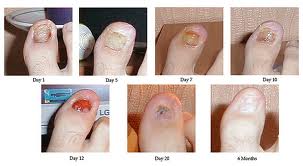 No one really knows. Little to no research has been done on removing all or part of the nail to treat a nail fungus infection. That’s because it’s sort of a last resort treatment for dealing with onychomycosis. However if you are unable to take any of the oral medications suggested for treating onychomycosis and if none of the topical solutions are effective, or if you have tried treating your nail fungus in several ways and none of them have been effective, then surgery may be an option.
No one really knows. Little to no research has been done on removing all or part of the nail to treat a nail fungus infection. That’s because it’s sort of a last resort treatment for dealing with onychomycosis. However if you are unable to take any of the oral medications suggested for treating onychomycosis and if none of the topical solutions are effective, or if you have tried treating your nail fungus in several ways and none of them have been effective, then surgery may be an option.
Another thing to consider is if you continue to experience recurring nail fungus infections, you might need to make some dietary changes and/or do a medical cleanse to get the possible sources of infection out of your system.
How does it work?
Your options for having your nail removed are as follows:
- Complete removal – known as avulsion
- Partial removal – known as debridement
There are also two options for having these procedures done:
- Surgery – Your doctor will numb the skin around and under your nail with a local anesthetic, either topical or a shot. Then a tool will be used to separate your nail from the surrounding skin and nail bed. (Your nail bed is the skin underneath your nail. This is most commonly where a nail fungus hides and breeds.) Once the nail has been removed your nail bed and surrounding skin should heal in 2-3 weeks.
- Ointment – Your doctor will cover the skin around your infected nail to protect it (similar to taping a window or door while painting.) Then an ointment will be put on the infected nail. The infected nail is covered with a plastic dressing, which will need to be kept dry. After a week to a week and a half, your nail should be soft enough to be removed by your doctor. The exposed nail bed and surrounding skin should heal in 2-3 weeks.
After you have undergone either of these procedures, your doctor will probably recommend taking an oral antifungal medication, or putting a topical ointment on the exposed nail bed to deliver the medicine directly to the affected area.
A fingernail, once the infected portion is removed should grow back healthy within about 6 months. A toenail may take up to 18 months to grow back.
If infection continues after this procedure, your doctor may recommend completely removing the nail again and putting a chemical on the cuticle (the soft layer of skin at the base of your nail) to prevent your nail from growing back.
Does it help?
Again, no one really knows as no one has put the time and research into the effects of removing part or all of the nail to cure onychomycosis.
So far, there is one reliable study that compared taking oral antifungal medication against other types of treatment, including removing part of the nail and putting a topical antifungal medication directly on the nail bed. The results were that people who chose the oral antifungal medication were happier with their treatment outcome than people who had part of their nail removed or who used any sort of topical remedy.
Possible Side Effects?
Once your nail has been removed from the nail bed, you will need to keep it clean and dry to prevent possible further infection of the area. Your doctor may also recommend using an antibiotic cream to ensure that everything heals well and stays healthy.
Another possible problem is that the side or corner of your nail could re-grow into the skin surrounding your toe. This is referred to as an ingrown toe nail. Mild symptoms of an ingrown toenail can be treated by soaking your foot in warm salt water and then propping the ingrown porting of your toenail to encourage it to grow above the skin. A more severe ingrown toenail will require you to return to your doctor for treatment.
The Places Toenail Fungus Like To Hide
The Places Toenail Fungus Like To Hide
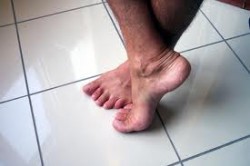 Permanently ridding yourself of a nail fungus infection once it has taken hold can be a very difficult job. The fungus grows slowly but strongly and by the time you see the initial symptoms, a great deal of damage has already occurred. The fungus likes to work its way underneath the nail so that it uses the nail as a shield to keep it warm and moist, its favorite growing environment. It also makes it easier for the infection to reoccur after what seems like successful treatment because the fungus can lie dormant underneath the nail, then start growing again once the treatment ceases.
Permanently ridding yourself of a nail fungus infection once it has taken hold can be a very difficult job. The fungus grows slowly but strongly and by the time you see the initial symptoms, a great deal of damage has already occurred. The fungus likes to work its way underneath the nail so that it uses the nail as a shield to keep it warm and moist, its favorite growing environment. It also makes it easier for the infection to reoccur after what seems like successful treatment because the fungus can lie dormant underneath the nail, then start growing again once the treatment ceases.
How Does a Nail Fungus Grow?
A fungus is a parasitic growth that prefers darkness to sunlight, as it has no chlorophyll. It does have roots and spreads via spores. Much like its cousin the mushroom, the body of the fungus looks like an umbrella. The spores spread and grow in dark, damp places. The most common cause of toenail fungus is wearing shoes as they hold in the moisture of sweat and keep the toenails in the dark. Also, most people wear the same pair of moisture absorbing shoes over and over again without allowing them to dry and air properly. Your body gives off both moisture and heat, providing the fungus with the perfect living environment.
Besides Shoes, Where Else Do Fungus Hide?
Exercise mats, such as yoga mats are ideal breeding grounds for the spores that cause nail fungus. Although the mat is made of rubber, which you would think is impenetrable, it soaks up the heat and moisture while you exercise. Then after your workout, you roll it up and stick it away until next time, providing the perfect growing environment for the fungus to attack your feet.
Flip-Flops that people wear into public showers are another good breeding ground for fungus, especially because most people don’t allow them to dry thoroughly before using them again. Ironically, the very item you use to protect your feet becomes the transmitter for the fungus you are trying to avoid.
Remedies To Treat Nail Fungus
There are many ointments and nail fungus solutions available over the counter or on the Internet to clear up nail fungus infections.
Most people try these, or home remedies before resorting to taking an oral antifungal medication to clear up the fungal nail infection as there are risky side effects associated with these treatments.
Mixing Tea Tree Oil and mineral oil as a toe soak is a home remedy solution. The mineral oil works to soften both the nail and surrounding skin, the Tea Tree Oil is a natural antifungal and antiseptic. Combined, these can be a powerful treatment for your nail fungus problem. This, and all nail fungus treatments, will take a while to show results and to cure the problem permanently, so you have to be patient and practice these remedies regularly so the full healing process can take place.
Common Nail Fungus Symptoms and Solutions
Common Nail Fungus Symptoms and Solutions
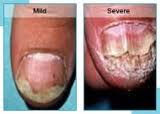 Suffering from some form of nail fungus is very common in humans. Because we find this embarrassing, we tend to hide the infected nail from view. This is especially true with toenails as they are easiest to hide inside a stuffy, warm set of shoes and socks.
Suffering from some form of nail fungus is very common in humans. Because we find this embarrassing, we tend to hide the infected nail from view. This is especially true with toenails as they are easiest to hide inside a stuffy, warm set of shoes and socks.
Solving this problem can be both easier, and more difficult than you think. There are many products available to cure nail fungus. However some of them include some risk of further problems, some don’t and will never work, and some people just have the problem of poor health that leads to continued infection.
What Causes Nail Fungus?
Every day we encounter many different microbes, microorganisms and bacterial. This is a normal part of life. Some of these turn out to be nail fungus spores. Most of the time, these are harmless as they are easily washed away. But if they manage to get into or under your nails, then they become problematic.
When the spore gets itself into a warm, dark, moist place on your body (most commonly your nails because they have that extra benefit of being a good shield from the world) they are able to grow and multiply, causing that nasty look of yellowing and thickness everyone associates with a nail fungus infection.
As the invasion by the fungus develops, so do the symptoms of nail fungus infection. The nail begins to become disfigured and can even get to the point where it crumbles or flakes away. This is most common in toenails because they spend so much time wrapped in socks and shoes, which creates a great breeding environment for the fungus.
How Do I Treat a Nail Fungus Infection?
There are several natural remedies available, as well as many home remedies that are recommended before you try the more aggressive method of taking an oral antifungal medication, which carries the risk of damage to your liver. Here are some suggestions:
• Tea Tree Oil – This natural essential oil is available at most health food stores. Rub the oil into the nail and surrounding skin a few times a day. Its antifungal properties will eventually kill the fungus
• Good Nail Hygiene – Keep your nails short, right at the edge of the toe and clean out the underside with a nail file to ensure no dirt is able to permanently lodge there. Keep your feet clean and dry and air them as much as possible by not wearing closed shoes.
• Vinegar – Soak your toes in a solution of vinegar and water, then wash and dry them thoroughly. The vinegar changes the pH of the growing environment, making it uninhabitable for the fungus.
If you have tried these solutions, and/or some of the others out there and nothing seems to make the nail fungus infection go away permanently, your next step is to consult with your health care professional to find a more standard medical solution to the problem. Be aware that some of these prescription solutions do carry risks so be sure to discuss this with your doctor and to make your doctor aware of all medications your are currently taking. During your treatment, continue to practice good nail hygiene as this will encourage the healing process and help to prevent spreading or continued nail fungus infection of your toenails.
Many solutions are available to treat this problem. Search the internet for alternatives before you commit yourself to taking an oral antifungal medication, especially if a child is the infected patient. If you do your research it will pay off in the long run.
A Quick Overview of Toenail Fungus Treatment Options
A Quick Overview of
Toenail Fungus Treatment Options
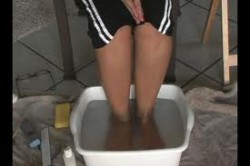 Toenail fungus is one of the most common and contractible diseases, as well as one of the most difficult to cure. The first thing you have to do is determine the cause of the infection. Is it fungal, bacterial, something else? And which kind of nail fungus is it? Is it Dermatophyte or yeast? Once your doctor has identified the source of the infection you can determine the course of treatment. Many people choose the home remedy path and find it very effective. Please note, if your nail fungus infection has reached the point where there is pain and/or drainage (oozing pus) you are well past the point where home remedies of any kind will work. If this is the case, you will need to find a standard medical solution to your problem.
Toenail fungus is one of the most common and contractible diseases, as well as one of the most difficult to cure. The first thing you have to do is determine the cause of the infection. Is it fungal, bacterial, something else? And which kind of nail fungus is it? Is it Dermatophyte or yeast? Once your doctor has identified the source of the infection you can determine the course of treatment. Many people choose the home remedy path and find it very effective. Please note, if your nail fungus infection has reached the point where there is pain and/or drainage (oozing pus) you are well past the point where home remedies of any kind will work. If this is the case, you will need to find a standard medical solution to your problem.
Home remedies really are effective, especially in treating toenail fungus. Many people consider alternative medicine to be “hippy dippy” or “out there” but something to consider is that only a couple hundred years ago, “alternative medicine” was the only medicine available. Many of the home remedies currently recommended are sometimes more effective than their standard medicine counterparts.
Some of these methods might sound a bit off-the-wall, but the science behind them is quite sound. Many of the natural fungicides recommended and available on the market are faster acting than some oral prescriptions. Soaking your feet in vinegar may sound gross, not to mention smelly, but vinegar has been used for centuries as a powerful disinfectant. Again, these are remedies to be tried in the early stages of nail fungus infection. Once the toenail fungus has caused the nail to separate from the nail bed, immersing your feet in vinegar or Listerine will be very painful, very quickly.
The modern medical community has created its own solutions to the problem of toenail fungus by producing various pharmaceutical products to treat the infection. If you have caught the infection early on, it is most likely that your doctor will prescribe a clear coat medicated nail polish. If the infection isn’t cleared up by this product, the next stage is to try an oral antifungal medication. This is a step that should only be taken while under the care of a medical professional as some of these products carry the risk of serious side effects and internal organ damage. You will have to check in with your doctor regularly if you choose this option, which does make it very expensive. You will also need to let your doctor know all medications, supplements and herbal remedies you are taking as this will reduce the possibility of a negative drug reaction during the course of your treatment.
The best cure for toenail fungus infection is prevention and/or early detection. Most people don’t notice a toenail fungus infection until it has progressed fairly far along as this is not something that causes significant discomfort and as it is not a regularly exposed area, people aren’t that concerned about it. The sooner you act to kill the invading toenail fungus, the easier it will be to make their extermination permanent.
Children and Nail Fungus Infections
Children and Nail Fungus Infections
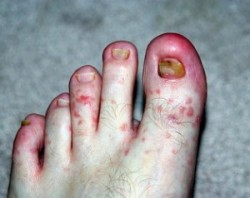 Although it is far less likely than not that a child will contract a nail fungus infection, it does happen. Onychomycosis, or nail fungus, is more commonly an adult disease, but as children spend a great deal of time getting into things they shouldn’t and playing in the dirt, they have as much potential as anyone else to attract the fungus that causes the infection.
Although it is far less likely than not that a child will contract a nail fungus infection, it does happen. Onychomycosis, or nail fungus, is more commonly an adult disease, but as children spend a great deal of time getting into things they shouldn’t and playing in the dirt, they have as much potential as anyone else to attract the fungus that causes the infection.
For kids, the infection is more of a social affliction than anything. Other children may see the infected nail and want to avoid the person with the nail fungus because they think they’ll get sick. This can be really rough on a child’s self esteem.
And as the nail fungus infection develops, the nail can become painful and even possibly fall off. So treating the infection, or better yet avoiding the infection entirely is the best solution.
The infection tends to show up as whitish or yellowish spots on the nail, then gradually grows to cover the nail surface entirely so that the nail is opaque. The nail will then become thicker and more brittle, possibly flaking or crumbling at the edges. Depending on the type of infection, the nail can disengage from the nail bed and fall off, which can be very painful.
How Can I Prevent My Child From Becoming Infected?
Start by teaching your children good hygiene. Make them wash their hands when they come inside after playing. This will quickly remove any spores they may have picked up outside. Get a soft nail-brush and show them how to scrub underneath their nails as well, as that can be a very common area that nail fungus attack.
Keep your children’s nails trimmed close to the tips of their fingers and toes, as the less exposed nail there is, the less surface is available to the spores to invade.
Put antifungal powder in their shoes overnight so they don’t risk infection from wearing shoes all the time. Wash their socks in bleach to kill off anything that might be lurking in the fibers.
If you do end up with a child contracting a fungal nail infection, simple methods of controlling the disease are:
• Rubbing Tea Tree Oil on the infected nail and surrounding skin
• Soaking the infected nail in a solution of vinegar and water twice a day
• Clean underneath the nails to remove the dirt and then wipe with rubbing alcohol to kill the fungus.
If these solutions don’t have an effect, you can speak with your child’s doctor about other available treatments. Some of these, particularly the oral antifungal medications, do carry the risk of liver damage, so be careful which option you choose, and make sure your child’s health is up to the treatment.